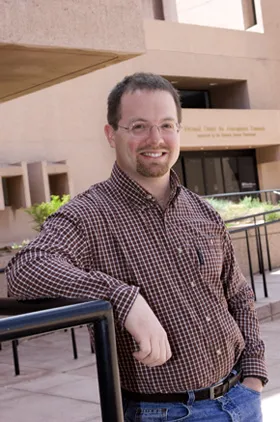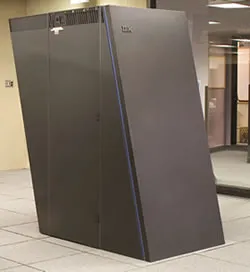Amik St-Cyr - Mathematician
Exploring the intersection of math, physics, and computer science

Amik St-Cyr
As a high school student in Montreal, Amik St-Cyr never guessed what he'd be doing a few years later. "If someone would have told me then that I was going to be a mathematician, I would have thought they were crazy," he recalls.
Little did Amik know that his career path was headed to NCAR's Institute for Mathematics Applied to Geosciences (IMAGe), where he works at the intersection of math, physics, and computer science. He sums up his research this way: "I answer physical questions with the right mathematical tools in an efficient way on supercomputers."
Amik spends much of his time studying numerical methods for solving partial differential equations, also known as PDEs. Mathematicians use these equations, which represent physical properties, to describe phenomena such as fluid flows, gravitational fields, and electromagnetic fields. PDEs have practical applications for aircraft simulation, computer graphics, weather prediction, and more. Amik refines and improves existing techniques for solving PDEs and also develops new techniques.
He is currently working on a computer model called the High-Order Multiscale Modeling Environment. HOMME incorporates advanced algorithms and computing techniques that enable it to use tens of thousands of computer processors. When coupled with NCAR's compact new Blue Gene supercomputer, HOMME may allow scientists to model atmospheric processes in greater detail without requiring computers that demand more power. "We're researching the ultimate numerical algorithms tied to the ultimate architecture for producing science faster," Amik says.
Another one of his interests is adaptive mesh refinement, a method of localizing one feature in a climate model and viewing it in higher resolution. He also studies ways to improve time-stepping methods; that is, methods for representing the advance of time in climate models. "The classic time-stepping scheme in atmospheric science, called the semi-Lagrangian scheme, is hard to implement on modern computers," Amik explains. "We've found a new way to do it that is compatible with modern computers and makes it very efficient."

Amik is part of a team at NCAR and the University of Colorado developing experiments for the IBM Blue Gene supercomputer, which is expected to produce simulations of the ocean, weather, and climate phenomena.
©UCAR, photos by Carlye Calvin
For Amik, the favorite thing about his job is problem solving. "I like going from a problem to a solution, implementing the solution and running a test, and then seeing it work on a daily basis," he says. "It's the whole deal, rather than just considering idealized problems all the time."
Ironically, Amik didn't enjoy math much until early in his college days at the University of Montreal, when he had the chance to study higher-level math and physics. Soon he discovered the field of numerical analysis. "I knew I wanted to do numerical analysis and apply it to partial differential equations to solve realistic problems," he says.
Amik went on to earn a doctorate in applied mathematics, also at the University of Montreal. Afterward, he held a post-doctoral appointment in parallel computing for computational fluid dynamics at McGill University in Canada. It wasn't until he came to NCAR in 2003 that he applied his mathematical knowledge to the atmospheric sciences. Before, his main interest was in the fluid flows known as supersonic flows.
In the future, Amik hopes to explore ways to model tornadoes and other severe weather events. He stays motivated by thoughts of seeing his ideas work. "As scientists, we like the feeling of being the first to discover something or witness something new," he says.
by Nicole Gordon
May 2005; February 2011